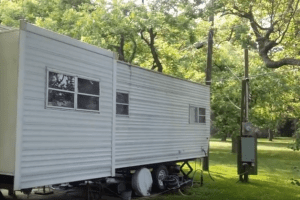
Move To Safer Housing, Mayor Urges Residents To Leave FEMA Trailers. Citing health concerns, New Orleans Mayor Ray Nagin says its time for city residents living in toxic trailers distributed by the Federal Emergency Management Agency (FEMA) to move to safer housing. Nearly 5,700 trailers remain in New Orleans, most on the private property of residents […]

Move To Safer Housing, Mayor Urges Residents To Leave FEMA Trailers. Citing health concerns, New Orleans Mayor Ray Nagin says its time for city residents living in toxic trailers distributed by the Federal Emergency Management Agency (FEMA) to move to safer housing. Nearly 5,700 trailers remain in New Orleans, most on the private property of residents who lost their homes to Katrina.
Late last year, the Centers for Disease Control (CDC) said there was an urgent need to get residents out of FEMA trailers because they emitted dangerously high levels of toxic formaldehyde fumes. But the lack of affordable housing in New Orleans, coupled with a slow rebuilding process has deterred many people from leaving the toxic FEMA trailers.
Thousands of people in Mississippi and Louisiana were given FEMA trailers as temporary housing following hurricanes Katrina and Rita. But by 2006 FEMA was getting reports from field workers along the Gulf Coast that residents of FEMA trailers where getting sick from the air in the toxic trailers. The first suspect was formaldehyde, which is used in the manufacture of the trailers. Despite the reports, e-mails uncovered last summer during a congressional investigation into the trailers showed that FEMA lawyers told the agency to drag its feet on air quality testing. FEMA’s Office of General Council also advised the agency not to test the trailers because doing so “would imply FEMA’s ownership of the issue”.
Formaldehyde is an invisible gas that is known to cause cancer. It can also cause other illnesses ranging from nose bleeds to chronic bronchitis. Commonly used in manufactured homes, formaldehyde can cause respiratory problems and has been classified as a carcinogen by the International Agency for Research on Cancer and as a probable carcinogen by the U.S. Environmental Protection Agency.
Late last year, FEMA and the CDC conducted air quality tests of 519 trailers. The CDC tests confirmed that the FEMA trailers posed a serious danger to residents still living in them. The average formaldehyde levels found in the toxic trailers measured 77ppb (parts per billions), significantly higher than the 10 to 17 ppb concentration seen in newer homes. When it announced its findings, the CDC urged FEMA to move residents from the toxic trailers as quickly as possible, with priority given to families with children, elderly people or anyone with asthma or other chronic conditions.
Up until now, Mayor Ray Nagin has refused to put pressure on residents to leave the trailers. But in an interview lwith the Associated Press, he said the approaching hurricane season, together with the formaldehyde issues has caused him to rethink his position. “We need to get everybody out,” Nagin said. “We need to find out if anybody’s health has been harmed and how do we deal with that, and find the housing that’s necessary so these people can get their lives together.”
But that’s easier said then done. Many of those living in trailers are still working on their damaged homes, and few can afford the additional rent of an apartment. A shortage of available housing in New Orleans also means many would end up in hotels, not a attractive prospect to many. In New Orleans, the city is working with the state and FEMA on housing options. One proposal being floated would redirect federal aid now paying for hotels or apartments for displaced residents toward fixing up damaged homes. It’s not very likely that the proposal could come to fruition by August, when hurricane season ramps up in earnest, raising fears that the trailers could not withstand a hurricane.
The personal injury attorneys at Parker Waichman LLP offer free, no-obligation case evaluations. For more information, fill out our online contact form or call 1-800-YOURLAWYER (1-800-968-7529).


